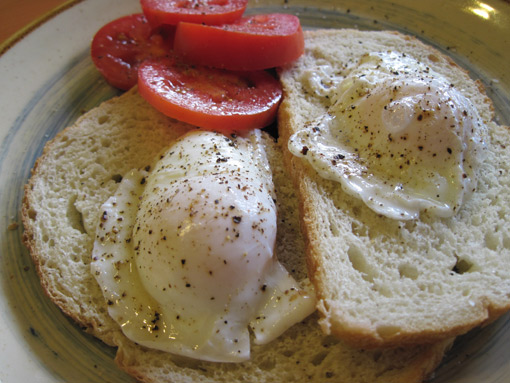
Poached eggs are one of those items we often see on menus and appreciate when eating out, yet wouldn’t attempt at home because we think they are too challenging to make with the humble tools found in our own kitchens.
Truth is, making poached eggs yourself is totally easy and involves only a single pot and a slotted spoon when it comes to the required hardware. As for skills, well if you can boil water, you can make poached eggs.
Poaching is a process in which foods are gently cooked in a liquid solution that is simmering, which means it’s just under a boil. You know you’ve reached a simmer when small bubbles are just coming up to the surface of the liquid.
While water is the obvious choice as a poaching liquid, wine, broth and even heavy cream can work, too.
Poaching is one of my favorite ways to cook because it’s nearly fool-proof and can be incorporated into many recipes. It’s a great way to keep fish tender and does wonders with chicken. When using the application for eggs, it yields soft clouds of white and a yolk that is still gooey and delicious in the middle.
While eggs Benedict and Florentine are two popular ways of enjoying poached eggs, I favor the simplicity of serving them on a bed of crusty toast, in which the crisp texture provides a great contrast to the softness of the eggs. Throw in some tomato slices on the side, and you’ve got yourself a quick and healthy meal.
Poached eggs are an extremely affordable and delicious breakfast, lunch or dinner, and they really stand out from the typical egg options like the standard old “scrambled.”
Here’s an easy recipe that will help you perfect the poach:
POACHED EGGS ATOP TOAST
(Yield: 1-2 servings)
- 1 teaspoon white distilled vinegar
- 1/2 teaspoon salt
- Two fresh, large eggs
- 2 slices of bread (whatever your preference)
- Garnish: Sliced Roma tomatoes (remember, tomatoes are glutamates and help make things taste better)
- Salt and pepper
Step 1: Fill a small to medium pot (1 quart or more is fine) with water and put on the stove over medium-high heat. Add the vinegar and salt to the water as it comes to a boil. The vinegar and salt will help prevent the white part of the egg from spreading, which is what often bedevils this process.
Step 2: When the water comes to a boil, lower the heat and wait a moment until it just starts to simmer. Remember, a simmer is when bubbles just barely reach the surface, as in the photo above.
Step 3: Crack the eggs into two small bowls, then gently place each egg in the water. They will sink and spread a bit. This is normal. By the way, when it comes to egg grading in the U.S., “AA” is better than “A,” and the fresher the egg, the better it holds its shape when cracked open.
Step 4: Let the eggs cook about four minutes in the simmering water. While this is happening, toast the bread and slice the tomatoes.
Step 5: Time for extraction. Arm yourself with a slotted spoon and a steady hand. Carefully lift the eggs out of the water, one at a time, shake off the excess water, and drop onto the awaiting slices of toast. Garnish with the tomatoes, a sprinkle of salt and pepper, and prepare to enjoy eggs in a whole new way.
Did you try this recipe? Write about your experience, ask questions or share advice in the comments area below.
Source: iwanttocook.com (defunct blog)

































